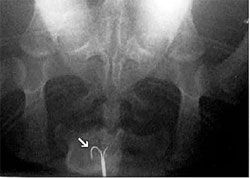Fishing lines kill sea turtles

24/01/2008
The loggerhead turtle (Caretta caretta) is one of the species of sea turtles which can be found in different parts of the world. One of the causes of their existence now being threatened is the increase in incidental captures by commercial fishing boats. When these turtles are captured, the fishermen throw them back to sea, with the hooks still in their digestive system. There is currently very little information on how this can affect their chances of survival. Every year in the Mediterranean Sea alone, thousands of turtles are accidentally captured with trawl hooks, and many of them end up dying.
A new study published by researchers of the UAB Wildlife Ecopathology Service describes the injuries found in four loggerhead turtles that were rescued by the CRAM Foundation in Premià de Mar. All four animals brought to the centre by fishermen had been trapped in fishing nets. The first two were already dead when they reach the centre, probably as a result of getting tangled in the net and drowning. One had a fish hook stuck in its oesophagus, which had provoked a chronic inflammation and fibrosis, while two fish hooks were found in the other turtle, which presented inflammation, fibrosis and an irregularly shaped granuloma.
Nonetheless, a previous research with eleven turtles with fish hooks in their digestive system revealed that half of them managed to expel the hooks on their own, without any apparent negative consequences. This is what happened to the third turtle taken to the centre. The centre's team took x-rays and detected a fish hook in the turtle's colon, near the cloaca. One week later, the turtle expelled the hook spontaneously. This points to the fact that it is not always possible to detect with x-rays if a hook has perforated the digestive system, since some turtles manage to expel them spontaneously. Therefore, before operating it is advisable to take another x-ray 72 hours after the first one, to verify whether the hook has moved.
The evolution of the fourth turtle was different, since it was in a state of shock when it was taken to the centre, and died 24 hours later. The necropsy revealed that the turtle had a hook stuck in its oesophagus and that it was attached to 40cm of fishing line. This produced the folding and necrosis (death of the tissues) of the intestine, which brought on the turtle's death. The fish hooks found in all four cases were smaller than those commonly used in trawl fishing (2-3 cm), and therefore were probably from sports fishing or traditional fishing lines. The hooks do not seem to have severe consequences on the turtles' lives, provided that the fishing line is cut as short as possible.
According to this research, the chances of survival of turtles that swallow long pieces of fishing line are low. This is due to the movements of the digestive system, which moves the fishing line down the system while, at the same time, the hook stuck in one place prevents it from moving further. Given that fishing lines are extremely resistant and cannot be degraded inside the body, the tensing of the line finally produces the folding and necrosis of the intestine.
This research clarifies the effects fish hooks have on the digestive system of loggerhead turtles, and demonstrates that the lethal effects are caused more by the traction of the line than by the hook itself. The size of the hook, where it is located, the length of the fishing line and the traction will determine the chances of survival. Until a solution can be found, researchers recommend that fishermen cut as much of the fishing line as possible from any turtles they find in their fishing nets. The lives of these animals depend on it.